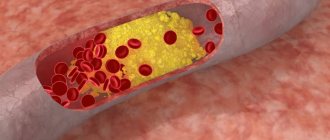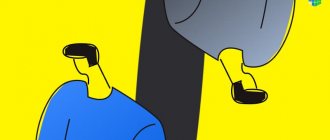.
There are more than 900,000 known species of insects on earth, but the most resilient of these creatures of nature is the cockroach. Many millions of years ago, a small insect appeared that survived the era of dinosaurs, the Ice Age and still lives side by side with humans, causing great inconvenience both in everyday life and psychologically. There are people who are terrified of these “creatures.” What is the name of the phobia, is it possible to fight it alone?
Blattophobia - fear of cockroaches
Brief description of the phobia
Many of us dream of these nasty insects disappearing from the face of the Earth. They are associated with unsanitary conditions and infections. But there is a category of people for whom these insects cause not just disgust, but panic fear. They understand that their excessive worry is unfounded, but they cannot do anything about it.
Fear of cockroaches is a phobia that greatly interferes with a person’s life. Officially it is called blattophobia.
According to research by the International University of Psychology in Berlin, every tenth inhabitant of the planet suffers from this phobia, and this fear comes from childhood. In most cases, it occurs as a result of psychological trauma.
The cause of injury can be various factors. In childhood, ideas about the beautiful and the terrible are formed in our subconscious, and cockroaches clearly do not fall into the first category. Children's consciousness is influenced by the example of parents who mercilessly hit a small insect with a slipper and scream heart-rendingly. Cinema also strengthens this idea by making horror films in which the red cockroach plays the “main roles”.
Women are more likely to be afraid of cockroaches
Also, people with increased nervous excitability, when faced with cockroaches, experience an enormous stressful situation, which in the future can provoke the appearance of a phobia of cockroaches. Women are at risk. The fact is that tactile sensations are important for women, and bodily contact with a dangerous insect causes them a feeling of disgust, which can degenerate into an obsessive fear of cockroaches.
Etiology of the phenomenon
It happens that a person simply does not like cockroaches and this is normal, i.e. we are not talking about a disease here. Everything can be explained by a banal feeling of disgust, which does not require treatment. In other cases, a person panics at the sight of a mustachioed insect, this already indicates psychological pathology, such people are called blattophobes.
The following factors can provoke the disease:
- Childhood stress. A person, while still a child, could become a participant in a situation in which there were cockroaches. After such an event, negative memories may remain in the memory, provoking fear of insects.
- Hereditary factor. Of course, blattophobia is transmitted at the genetic level, but if a child’s parents experience an uncontrollable fear of insects, then one can most likely expect that the children will also suffer from a similar phobia.
- Children's fairy tales. A child’s wild imagination can draw an evil monster in the form of a cockroach, for example, after reading Chukovsky’s poem “The Cockroach,” because everyone was afraid of this anti-hero in the fairy tale.
- Films featuring scary cockroaches. The modern film industry boasts a huge number of films where the roles of the main characters go to insects. While watching such film projects, a person may form the wrong idea about cockroaches. In such films, small insects are presented as huge destroyers, killing people and destroying everything in their path.
- Repulsive look. Not a single species of cockroach can boast of attractiveness. All of them are disgusting to one degree or another.
- Diseases. Everyone knows that insects can be carriers of various diseases. Among patients with blattophobia, there are many who are simply afraid of catching something from cockroaches. Especially if a person is already sick with something after an insect bite.
Symptoms of the disease
The most common symptoms are the following; they can appear individually or as a group:
- inappropriate actions and behavior (squealing, waving arms, etc.);
- an irresistible desire to avoid contact with insects;
- asthma attacks, heart attacks;
- uncontrollable sobs, hysterics (the person understands the absurdity of his behavior);
- lightheadedness or fainting;
- trembling in the body;
- nausea, sweating;
- throat spasm;
- stupor;
- panic.
Panic is a common occurrence when you see a cockroach.
Symptoms of manifestation
The symptoms of the disorder include several points, the presence of which a specialist can determine abnormalities. Nyctophobia is formed from signs that are common to everyone and special that are unique to it.
The following are considered common:
- increased heart rate and breathing problems;
- present headaches;
- nausea; gag reflexes;
- in special cases, there is a loss of control over one’s own movements;
- speech disorder.
Special ones include:
- severe manifestations of the above symptoms of nyctophobia;
- development of panic and increased anxiety with the arrival of darkness.
Strong worries prompt a person to constantly monitor his own mental safety. This is expressed in avoiding dark moments. Preventive measures include constantly checking that lighting is working properly and ensuring a high level of home safety. The person who carries out such actions is not able to adequately evaluate his behavior and considers it rational and completely logical. The present misunderstanding of such behavior by loved ones often provokes conflict situations in the family. Regular hot temper, problems with sleep, tears, constant checking of one’s actions are signs indicating a long-term destructive effect.
Methods for dealing with phobias
Taking your fear of cockroaches for granted is not a solution to the problem, but a self-defeating escape attempt. Fear destroys a person's life, and it takes a lot of effort to become the master of your fear, and not remain a prisoner. Accept the problem, understand it and start fighting using an integrated approach. Cockroach phobia can be treated using psychotherapy or medication.
Drug treatment
Medicines are prescribed exclusively by a doctor. Self-treatment can lead to serious consequences.
The list of medications below is for informational purposes only.
- Tricyclic antidepressants (Fluoxetine, Sertraline).
- Weak tranquilizers (Phenazepam, Imipramine). They must be used directly during panic attacks.
- Tablets that block the feeling of increased anxiety during an encounter with an insect. These include Buspirone.
But medications can only help temporarily, directly during a panic attack, when the patient needs to be calmed down by giving a soothing decoction or pills.
Medicines must be taken as prescribed
Other methods to get rid of the problem
The main assistance in the fight against blattophobia can be provided by qualified psychotherapists or psychiatrists. They will teach you how not to succumb to phobias and reduce the negative impact of stress on the body. Treatment for each individual is selected individually, as it depends on many factors.
- Hypnosis is a state in which suggestibility increases and the absence of fear of a phobia is imprinted in the subconscious. Not all patients will agree to this method of treatment, all because of the same fear, but all phobias can be treated with hypnosis. The doctor puts the patient into a trance and, asking him leading questions, determines the true cause of fear.
Hypnosis against phobias
- The method of autogenic training consists in mastering the technique of self-hypnosis, in which a feeling of heaviness arises in the body, as a result of which a state of muscle relaxation is achieved, the so-called. relaxation. To do this, you need to turn on calm music, relax, even out your breathing, turn off your emotions, close your eyes and start saying self-hypnosis phrases: “I am brave.” I easily overcome my fear”, “I know that my fear is created by me, which means I can overcome it”, “I turn off my fear of (cockroaches) for the whole day.”
- The practice of yoga is a good helper in the fight against phobias. Regular yoga classes provide an outlet for our fears, gradually eliminating the level of anxiety.
- One of the effective techniques in struggle is to face your fear. By overcoming yourself, you will overcome your phobia. The exit should not be rapid, but gradual.
- Playing sports in the fresh air is a cure for many diseases, including blattophobia.
Famous people suffering from blattophobia
Celebrities who suffer from an uncontrollable fear of cockroaches:
- Peter I is famous for his strong character, but he had an extremely negative attitude towards cockroaches. All the places where he stopped during his travels were checked by the courtiers for the presence of these insects.
- Scarlett Johansson - the famous actress developed an acute panic attack after she woke up feeling a cockroach on her face.
- Woody Allen. Known not only for his numerous Oscars, but also for his phobias; he is afraid of literally everything, including cockroaches.
- Nadine Coyle, a famous actress, is also afraid of many animals, especially those that can bite. She hates cockroaches because of their external unattractiveness.
- Johnny Depp - he once had to pay the cost of restoring a hotel room in the amount of 10 thousand dollars. He later explained his violent behavior by saying that he was hunting a large cockroach, which he imagined was in the apartment.
- Philip Kirkorov does not hide it and declares publicly: I am afraid of cockroaches and frogs, although he is loyal to other insects and reptiles.
- Ilya Lagutenko can’t stand literally all insects, including cockroaches.
Blattophobia is a rather serious problem, and it must be combated. In advanced cases, the outcome is unknown - everything can end in convulsions or paralysis.
Alternative medicine for treating insect fear
As a sedative for neurasthenic conditions, tincture of peony, motherwort, and hawthorn is used, 25-35 drops 3 times a day, the course of treatment is a month. For general calming of the nervous system, take fresh motherwort herb juice 30-40 drops 3-4 times a day 30 minutes before meals. For neurasthenic conditions, you can also use the following decoction: pour 1 tablespoon of peppermint leaf into 1.5 cups of hot water, cook for 15 minutes over low heat, take 0.5 cup three times a day.
The main thing is to promptly recognize the presence of a problem, do not delay treatment and visit a specialist who will definitely be able to help you overcome your fears.
Nyctophobia in an adult
Any phobia can and should be overcome, especially if it interferes with normal life activities. There are two ways: pharmacological and psychotherapeutic. Early diagnosis is the key to a successful outcome.
Pharmacological
This pathology is partially controlled by psychoactive drugs. They will not cure the main source, but they can eliminate external manifestations. Such drugs are strictly not recommended for self-medication. The following are medications that eliminate symptoms:
- antidepressants;
- hypnotics (sleeping pills);
- sedatives.
Remember that you can’t do it with medications alone. The psychotherapist decides which, in combination with medication, will be the optimal solution.
Psychotherapy for nyctophobia
Psychotherapy is considered the most effective way today. Only in the office of a psychologist or psychotherapist will you be able to talk about what you cannot share even with your family. When choosing the type of psychotherapy, you should rely on your own feelings, because everything depends on purely individual characteristics. For some, gelstat therapy is suitable, and for those who are unstable to hypnosis, hypnosuggestive therapy will be relevant. The doctor will choose the best direction for recovery.
Serious form of disorder
More severe forms of phobia occur. Some doctors are of the opinion that in most cases phobia is not a disease, others are convinced that it is a symptom of a mental disorder.
In any case, the fear, anxiety or fear experienced by people suffering from this condition is different from the natural anxiety experienced by ordinary people.
And if fear is a normal psychological reaction that occurs in response to a situation of real danger or threat, then phobia is a state that does not follow rational logic, and the feeling in these situations does not correspond to the danger that it actually poses.
A phobia can vary in duration, cause physical and psychological reactions, and seriously impair quality of life.
In the hospital
If it is not possible to independently treat the disease nyctophobia, you should make an appointment with a psychotherapist. Phobias respond well to the psychotherapeutic method; hypnotherapy, various relaxing techniques and special training are often used. The use of only medications provides a short-term and unstable effect. During the period of exacerbation, the patient is prescribed one sedative drug that relieves the symptoms of the disease. Body-oriented and cognitive-behavioral techniques help to cope. The rule states that children need to create a special environment for sleep - use a night light, relaxing music, fairy tale therapy at night.
In the hospital, the clinic’s specialists treat nyctophobia and rely on the principles of proven medicine, using one effective psychotherapeutic paradigm that has received recognition in the community. The main method of work is cognitive behavioral therapy, which leads to good results in a couple of sessions. Next, these thoughts change and the emotional state stabilizes. Understanding all the processes makes it possible for suffering people to change their behavioral pattern and say goodbye to the psychological issue.









